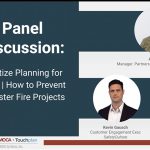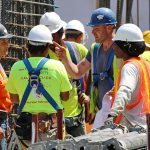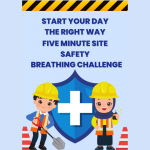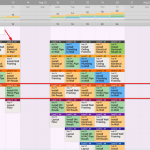(Guest blog post by Michel Richer, Content Marketing Manager at Bridgit.)We’ve all been overwhelmed and stressed at work at some point in our lives. It’s that sinking feeling that there’s no clear path to getting back on track. Deadlines slip, communication is lackluster, and ultimately the end product isn’t up to standard.
Burnout is almost unavoidable in most full-time occupations. Understandably so given the current ‘pandemic climate’ forcing shutdowns and putting added pressure on workers to hold onto their jobs. Not to mention the parents that have had to reorganize their entire lives to accommodate school closures and supervising kids into their workday.
Construction is unlike most industries when it comes to overworking employees and workplace injuries. Especially since the industry has been dealing with a skilled labor shortage since the financial crisis in 2008 saw over a million workers walk away from construction, leaving those left to pick up the slack. Research from the Center for Construction Research and Training suggests that over their career, a construction worker has a 75% likelihood of a disabling injury.
While burnout can certainly take its toll on an individual’s psychological and physiological health, the effect it can have on the rest of a construction team cannot be understated.
Construction project roles will require team members to do physical labor while also using their mental expertise. Adding in longer weeks and extended shifts to make up for a labor shortage only helps to amplify the stress felt by team members. This stress causes team members to be less focused on the job at hand and on a construction project. The end result is an increasingly dangerous working environment. According to a report by the Occupational Safety and Health Administration (OSHA), team members working over 12 hours/day are at 37% increased risk of injury.
The risk doesn’t end there though. The same report indicates that each extended shift within a month increases the risk of an accident on the drive home by 16% and that fatigue has led to a dip in productivity, costing employers $136 billion each year.
COVID-19 has also amplified burnout in the workplace. Indeed, a leading job aggregator site conducted a survey of over 1,500 American workers regarding burnout. The survey found that over half of the respondents experienced burnout in 2021, up 9% from before the pandemic started.
Here are some other interesting burnout statistics that might make you rethink how your organization deals with it:
- Burnt out employees are 63% more likely to call in sick (Gallup)
- Burnt out employees are also 2.6 times more likely to be looking for a new job (Gallup)
- 70% of employees say employers don’t do enough to lessen burnout for their teams (Deloitte)
- Almost 50% of millennials have quit a job due to burnout (Deloitte)
Burnout isn’t exclusive to the jobsite either. In Development Dimensions International’s Global Leadership Report it was revealed that 60% of leaders within a company feel exhausted at the end of their workday, which is a sign burnout is imminent. On top of that, almost half of that 60% expect to leave their current company to advance their career – with 26% reporting they would be leaving in the next year.
Any company-wide initiatives will always start from the top down. If your leadership team is showing signs of burnout, it’s likely that your project teams are too. This puts the project, the people, and the company all at risk of unfocused work leading to workplace injuries.
What exactly is burnout though?
In 2019, the World Health Organization (WHO) determined burnout was a diagnosable condition. As overall productivity has increased, so has the stress and mental fatigue of maintaining a productive workplace. Their definition of workplace burnout is:
“Burn-out is a syndrome conceptualized as resulting from chronic workplace stress that has not been successfully managed. It is characterized by three dimensions:
- feelings of energy depletion or exhaustion;
- increased mental distance from one’s job, or feelings of negativism or cynicism related to one’s job; and
- reduced professional efficacy.
Burn-out refers specifically to phenomena in the occupational context and should not be applied to describe experiences in other areas of life.” – World Health Organization 2019
How contractors can combat employee burnout
Flexible schedules and encouraging time off
With team members experiencing burnout more likely to call in sick, one way to combat this is with flexible scheduling and more paid time off. I know what you’re thinking – “isn’t this going to cost my company a lot of money?”.
While in the short term the answer may be yes, what you’re creating is a working culture that will save money in the long run. Your employees will know that their mental and physical well-being are prioritized and will be more engaged with the company and less likely to seek employment elsewhere. In fact, a survey by Statista indicated that 58% of respondents said flexible working has improved their job satisfaction. Remember, reducing the risk of burnout also helps to reduce the risk of jobsite injuries.
Flexible schedules also allow you to prepare for time off. Calling in sick can quickly put a wrench in project plans, but encouraging your team to schedule time off ahead of time allows you to plan accordingly to avoid project delays.
Track and promote career development
One of the contributing factors to burnout is not having a clear path for career progression. Employees not only want to feel like they are contributing to the company’s success, they also want to feel like the work they’re doing is going to impact their career and help propel them forward within the company.
By tracking your team’s career progression you’re better equipped to provide opportunities to move up the ranks, making them more likely to stay engaged in their work, the company, and ultimately reduce the risk of burnout-related injuries on the jobsite.
Pay attention to things like specific build-type experience and certifications. This can help to isolate gaps in your team’s individual resumes that are preventing them from taking the next career step within your company. Employees will feel more appreciated if they’re given opportunities to further their careers instead of hesitating to ask for them.
Pay attention to utilization rates
Tracking workforce utilization rates can help identify areas where your team is spread too thin on both current and future projects. Being able to identify these areas can help to inform recruitment strategies and better understand the impact that project opportunities will have on your team.
Workforce intelligence tools like Bridgit Bench provide company-wide insight into utilization to help identify when individuals are being overworked. If you notice a team member is consistently being utilized over 100%, you should take the time to have a conversation with them. Finding out their mental and physical state will help to nip potential burnout in the bud and keep projects not only progressing but most importantly – safe.
While burnout and mental health are only a small part of the larger health and safety picture that doesn’t mean it should be deprioritized. Mental health is at the top of the health and safety stream. Fatigued and disengaged team members will ultimately lead to bigger problems downstream whether it be workplace injuries or decreased retention rates.
For more Construction Safety Week content please check out our additional posts; Private Eyes: Construction Safety Isn’t Just About a Week and Why Safety Third is Exactly What Construction Needs to Make Jobsite Safety First.










